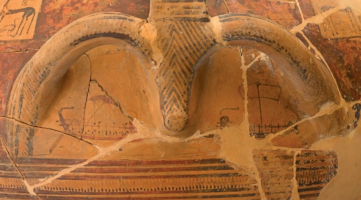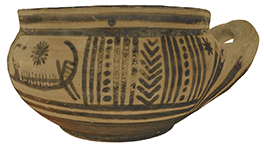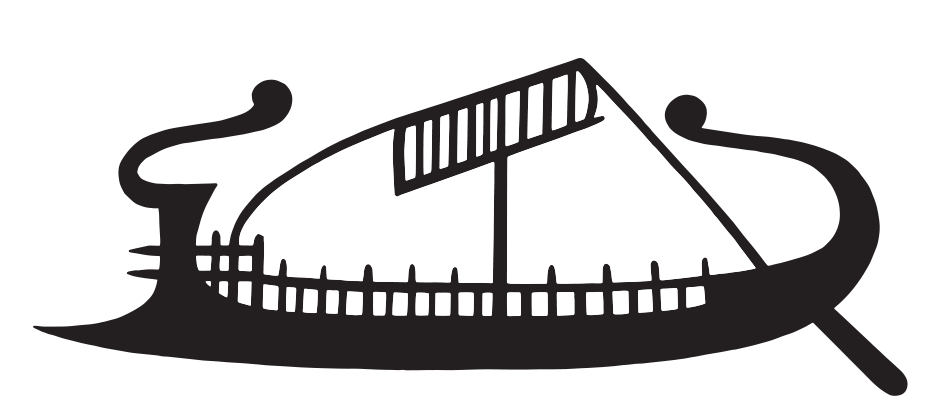Low flat hull, with the keel-line painted as a continuous line that extends from the tip of the bow projection to the curving stern. Solid concave stempost integrating the bow projection and ending in an S-shaped horn that inclines slightly forward, then backwards parallel to the hull. Long tapering ram, with two shorter planks protruding above it (proembolia). Forecastle with lattice railing (protective palisade). High curving stern ending in a horn incurving sharply forward parallel to the hull (aphlaston) and a steering oar. The horizontal line above the hull represents the railing, with the two connected by 19 vertical strokes. As on the New York ships, these form a pattern, alternating between touching the gunwale line, and extending above it. The protruding verticals, numbering 10, are tholepins. A mast is depicted amidships, which is only slightly taller than the bow and stern ornaments. The yard is raised to the top of the mast, with a rectangular sail intersected by vertical lines which represent the brails. There are two braces, one connecting each end of the yard to the bow and stern.
Galley with a deployed sail
A124
c. 775-760 B.C. (MG II, end of first quarter or beginning of second quarter of 8th century)
Moulki, tomb 4 (near ancient Corinthian Cromyon)
H: 34 cm; max. diameter: 22 cm; base diameter: 13.5 cm
Attic oenochoe, broad low ring foot, tall body with a high straight neck, vertical handle and trefoil mouth. Light orange clay, black to brownish paint. Import confirmed by atomic absorption analysis
Tzahou-Alexandri 1990: 333-334, figs. 1-2
Complete ship to the left in a reserved panel between two mastoid knobs on the shoulder, accentuated by two painted semicircles. Found in a tomb among four other vases. The total length of the ship including the ram is 9 cm.
The problem in interpretation concerns the 19 verticals. Tzahou-Alexandri proposes that these must form a decorative band similar to the Eleusis ship, and thinks that these are unlikely to be oarports. There is nothing to support this interpretation since unlike the Eleusis example, these are not obliques. Their alternating pattern should be seen as meaningful, as it is obviously deliberate and parallels the one observed on the New York ships. The tholepins remain the reliable indicators of the length of the ship, suggesting a vessel manned by 20 rowers. While the interpretation as oarports can thus be put aside, there are other alternatives for the verticals: they could represent the frames of the ship, a raised deck, or simply a raised railing supported by struts. The latter would have allowed for a very low and therefore light hull, all the while keeping the oars on a high level. The rounded endings of the horns are peculiar to this depiction.
Tzahou-Alexandri, O. 1990. “Contribution to the knowledge of 8th century B.C. Ship Representations,” in H.E. Tzalas (ed.) Tropis II: 2nd International Symposium on Ship Construction in Antiquity. Delphi 1987 (Hellenic Institute for the Preservation of Nautical Tradition). Athens: Hellenic Institute for the Preservation of Nautical Tradition, pp. 333-61.








